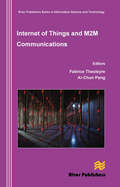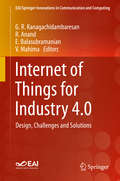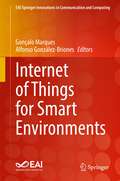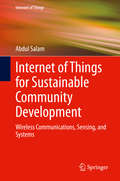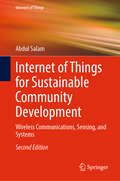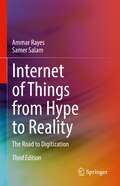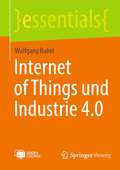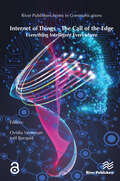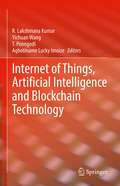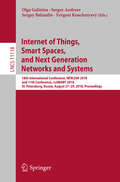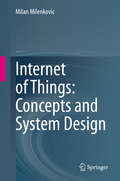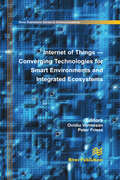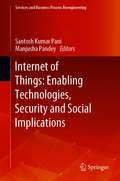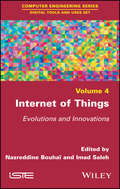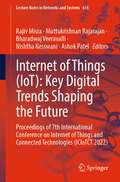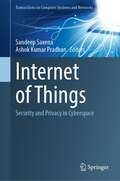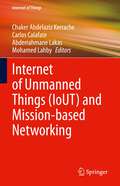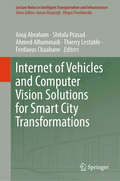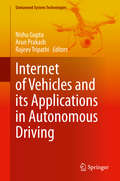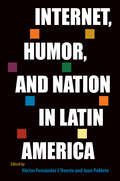- Table View
- List View
Internet of Things and M2m Communications
by Ai-Chun Pang Fabrice TheoleyreThe Internet of Things is the emerging technology which interconnects smart objects using wireless communications. After having been extensively studied in academic labs, the Internet of Things is now widely applied in the industrial world (e.g. domestic automation, smart metering, smart cities).
Internet of Things and Sensor Network for COVID-19 (SpringerBriefs in Applied Sciences and Technology)
by Nagender Kumar Suryadevara Siba Kumar UdgataThis book examines various models/solutions in areas, such as individuals, home, work and society, where IoT and AI are being utilized to mitigate the Covid-19 pandemic. The world is battling with the novel coronavirus, and government authorities, scientists, medical practitioners, and medical services are striving hard to help people to face the challenges. During this crisis, numerous innovative ideas and solutions have been proposed for using the Internet of things (IoT), sensor networks, and artificial intelligence (AI) to monitor the wellbeing of individuals. Nations are using all available assets to help develop cutting-edge innovations to relieve the impacts of Covid-19 and profile individuals in danger. The advances in IoT frameworks and sensor technologies together with AI are invaluable in the context of this pandemic, and nations and various entities around the globe are discovering innovative solutions to maintain businesses and help people live alongside Covid-19. This book presents the advances in sensor technologies, IoT frameworks, and explores how these technologies are being used to deal with the issues arising from Covid-19, including work in progress and potential applications.
Internet of Things for Human-Centered Design: Application to Elderly Healthcare (Studies in Computational Intelligence #1011)
by Sofia Scataglini Gonçalo Marques Silvia ImbesiThe book presents the state of the art of the Internet of Things (IoT), applied to Human-Centered Design (HCD) projects addressed to ageing users, from the perspective of health, care and well-being. The current focus on the ageing population is opening up new opportunities for the development of niche solutions aimed at the niche category of older users who are beginning to experience physical and cognitive decline but are still independent and need to maintain their autonomy for as long as possible. The combination between the needs expressed by older users and the opportunities offered by the recent innovative technologies related to the Internet of Things allows research institutions, stakeholders, and academia to target and design new solutions for older users, safeguarding their well-being, health, and care, improving their quality of life. This book discusses and analyses the most recent services, products, systems and environments specifically conceived for older users, in order to enhance health, care, well-being and improve their quality of life. This approach is coherent with the percept of AAL or enhanced living environment, looking to the users’ comfort, autonomy, engagement and healthcare. The book describes and analyses aspects of HCD with older users looking to the emerging technologies, products, services, and environments analysed in their actual application in different areas, always concerning the design for the elderly related to the IoT, just as the development of biomonitoring devices, tools for activity recognition and simulation, creation of smart living environments, solutions for their autonomy, assistance and engagement enhancing health, care and wellbeing. The book is intended for researchers, designers, engineers, and practitioners in healthcare to connect academia, stakeholders, and research institutions to foster education, research and innovation.
Internet of Things for Industry 4.0: Design, Challenges and Solutions (EAI/Springer Innovations in Communication and Computing)
by G. R. Kanagachidambaresan R. Anand E. Balasubramanian V. MahimaThis book covers challenges and solutions in establishing Industry 4.0 standards for Internet of Things. It proposes a clear view about the role of Internet of Things in establishing standards. The sensor design for industrial problem, challenges faced, and solutions are all addressed. The concept of digital twin and complexity in data analytics for predictive maintenance and fault prediction is also covered. The book is aimed at existing problems faced by the industry at present, with the goal of cost-efficiency and unmanned automation. It also concentrates on predictive maintenance and predictive failures. In addition, it includes design challenges and a survey of literature.
Internet of Things for Smart Cities: Technologies, Big Data and Security (SpringerBriefs in Electrical and Computer Engineering)
by Alagan Anpalagan Waleed EjazThis book introduces the concept of smart city as the potential solution to the challenges created by urbanization. The Internet of Things (IoT) offers novel features with minimum human intervention in smart cities. This book describes different components of Internet of Things (IoT) for smart cities including sensor technologies, communication technologies, big data analytics and security.
Internet of Things for Smart Environments (EAI/Springer Innovations in Communication and Computing)
by Alfonso González-Briones Gonçalo MarquesThis book aims to introduce recent advances in IoT and its applications for smart environments. The state of the art is reviewed with a focus on the technologies, applications, challenges, and opportunities. At this stage, a comprehensive understanding of the formal and practical applications of IoT in the different scenarios of smart environments is necessary to support future research. Therefore, the main contribution of this book is a comprehensive study of the most recent proposals for smart environments. In addition, this book synthesizes existing information and highlights common threads and gaps that lead to new and complex areas of future research. The book covers a range of major research subjects which will foster future implementations. The topics include smart learning environments, crowdsensing applications, participatory citizen sensing, multimodal perception systems and security challenges. This book seeks to provide a valuable framework for future research projects by expounding the topic to academics, engineers, and industry professionals, which is necessary for the design of future IoT architectures for smart environments.
Internet of Things for Sustainable Community Development: Wireless Communications, Sensing, and Systems (Internet of Things)
by Abdul SalamThis book covers how Internet of Things (IoT) has a role in shaping the future of our communities. The author shows how the research and education ecosystem promoting impactful solutions-oriented science can help citizenry, government, industry, and other stakeholders to work collaboratively in order to make informed, socially-responsible, science-based decisions. Accordingly, he shows how communities can address complex, interconnected socio-environmental challenges. This book addresses the key inter-related challenges in areas such as the environment, climate change, mining, energy, agro-economic, water, and forestry that are limiting the development of a sustainable and resilient society -- each of these challenges are tied back to IoT based solutions.Presents research into sustainable IoT with respect to wireless communications, sensing, and systemsProvides coverage of IoT technologies in sustainability, health, agriculture, climate change, mining, energy, water management, and forestryRelevant for academics, researchers, policy makers, city planners and managers, technicians, and industry professionals in IoT and sustainability
Internet of Things for Sustainable Community Development: Wireless Communications, Sensing, and Systems (Internet of Things)
by Abdul SalamThis updated book presents research on how Internet of Things plays a part in shaping the future of our communities. The author shows how the research and education ecosystem promoting impactful solutions-oriented science can help citizenry, government, industry, and other stakeholders to work collaboratively in order to make informed, socially-responsible, science-based decisions. The author also provides updated data on how communities can address complex, interconnected socio-environmental challenges. This book addresses the key inter-related challenges in areas such as the environment, climate change, mining, energy, agro-economic, water, and forestry that are limiting the development of a sustainable and resilient society -- each of these challenges are tied back to IoT based solutions.
Internet of Things from Hype to Reality: The Road to Digitization
by Ammar Rayes Samer SalamThis revised textbook presents updated material on its core content: an end-to-end IoT architecture that is comprised of devices, network, compute, storage, platform, applications along with management and security components. As with the second edition, it is organized into six main parts: an IoT reference model; fog computing and the drivers; IoT management and applications; smart services in IoT; IoT standards; and case studies. This edition’s features include overhaul of the IoT Protocols (Chapter 5) to include an expanded treatment of low-power wide area networks including narrow band IoT (NB-IoT) protocol, updated IoT platforms and capabilities (Chapter 7) to include comparison of commercially available platforms (e.g. AWS IoT Platform, Google Cloud IoT Platform, Microsoft Azure IoT Platform, and PTC ThinkWorx), updated security (Chapter 8) to include approaches for securing IoT devices with examples of IoT devices used in security attacks and associated solutions including MUD and DICE, and finally new Appendix B to include six IoT project detailed for students.
Internet of Things in Modern Computing: Theory and Applications (Smart Technologies for Engineers and Scientists)
by Naveen Kumar Abhinav Sharma Vinay Chowdary Vivek KaundalThe text focuses on the theory, design, and implementation of the Internet of Things (IoT), in a modern communication system. It will be useful to senior undergraduate, graduate students, and researchers in diverse fields domains including electrical engineering, electronics and communications engineering, computer engineering, and information technology. Features: Presents all the necessary information on the Internet of Things in modern computing Examines antenna integration challenges and constraints in the Internet of Things devices Discusses advanced Internet of Things networks and advanced controllers required for modern architecture Explores security and privacy challenges for the Internet of Things-based health care system Covers implementation of Internet of Things security protocols such as MQTT, Advanced Message Queuing Protocol, XMPP, and DSS The text addresses the issues and challenges in implementing communication and security protocols for IoT in modern computing. It further highlights the applications of IoT in diverse areas including remote health monitoring, remote monitoring of vehicle data and environmental characteristics, industry 4.0, 5G communications, and Next-gen IoT networks. The text presents case studies on IoT in modern digital computing. It will serve as an ideal reference text for senior undergraduate, graduate students, and academic researchers in diverse fields domains including electrical engineering, electronics and communications engineering, computer engineering, and information technology.
Internet of Things in Smart Technologies for Sustainable Urban Development (EAI/Springer Innovations in Communication and Computing)
by R. Maheswar G. R. Kanagachidambaresan V. Manikandan K. RamakrishnanThis book provides solution for challenges facing engineers in urban environments looking towards smart development and IoT. The authors address the challenges faced in developing smart applications along with the solutions. Topics addressed include reliability, security and financial issues in relation to all the smart and sustainable development solutions discussed. The solutions they provide are affordable, resistive to threats, and provide high reliability. The book pertains to researchers, academics, professionals, and students.Provides solutions to urban sustainable development problems facing engineers in developing and developed countriesDiscusses results with industrial problems and current issues in smart city developmentIncludes solutions that are reliable, secure and financially sound
Internet of Things und Industrie 4.0 (essentials)
by Wolfgang BabelDie Ursprünge von IoT gehen von Kevin Ashton zurück bis zu den RFID-Sensoren in den 70er Jahren. Industrie 4.0 basiert ebenfalls auf den Ideen von IoT mit dem wesentlichen Punkt der globalen Internetkommunikation: Wer IoT sagt, meint Industrie 4.0 und umgekehrt. IoT ist von Industrie 4.0 nicht mehr zu trennen. Die Geschichte und die Zusammenhänge von IoT und Industrie 4.0 werden auf anschauliche Weise anhand von Beispielen erklärt, angefangen vom Ethernet TCP/IP, über die generelle Automatisierungsstrategie bis hin zu den grundlegenden vertikalen und horizontalen Kommunikationsprotokollen, bei denen heute OPC UA und Cloud Computing eine tragende Rolle zukommt.Den kostenlosen Zugang zum Online-Kurs finden Sie direkt im Buch.
Internet of Things – The Call of the Edge: Everything Intelligent Everywhere
by Ovidiu Vermesan Joël BacquetThis book provides an overview of the Internet of Things (IoT) – covering new ideas, concepts, research and innovation to enable the development of IoT technologies in a global context. The work is intended as a standalone book in a series covering the activities of the Internet of Things European Research Cluster (IERC) – including research, technological innovation, validation, and deployment.The book chapters build on the developments and innovative ideas put forward by the IERC, the IoT European Large-Scale Pilots Programme and the IoT European Security and Privacy Projects – presenting new concepts, ideas and future IoT trends and ways of integrating open data frameworks and IoT marketplaces into larger deployment ecosystems.The IoT and Industrial Internet of Things technologies are moving towards hyperautomated solutions – combining hyperconnectivity, artificial intelligence (AI), distributed ledger technologies and virtual/augmented extended reality, with edge computing and deep edge processing becoming an assertive factor across industries for implementing intelligent distributed computing resources and data to keep the efficient data exchange and processing local to reduce latency, exploit the sensing/actuating capabilities and enable greater autonomy.Expanding the adoption of consumer, business, industrial and tactile IoT requires further development of hyperautomated IoT concepts for collaborative solutions involving machines and humans to expand augmented creativity at the application level using AI to optimise the industrial processes and progress towards a symbiotic economy based on distributed federated cloud/edge infrastructure allowing resource sharing in the form of computing, memory and analytics capabilities.The advances of autonomous IoT applications delivering services in real-time encompasses development in servitisation, robotisation, automation and hyperconnectivity, which are essential for the rapid evolution of industrial enterprises in the new digital era. The rise of digital twins integrated into IoT platforms as fully interactive elements embedded into the simulation and optimisation environment, as well as the embedment of AI techniques and methods, enhances the accuracy and performance of models in the various IoT and Industrial Internet of Things applications.The convergence of technologies to provide scalable, interoperable IoT-enabled applications pushed the requirements for high bandwidth, low latency and robust and dependable connectivity to support the industry’s demand for deeper integration and improved analytics to deliver sustainable competitive advantage products and services, enabling digital transformation with a focus on new business models.Safety and security are interlinked for the next wave of IoT technologies and applications and combined, prove a greater value for rapid adoption.The new IoT technologies are essential for facilitating sustainable development, reducing energy consumption and, by supporting the optimisation of products and processes, mitigating unnecessary carbon emissions – thereby reducing the environmental impact through real-time data collection, analysis, exchange, and processing.
Internet of Things, Artificial Intelligence and Blockchain Technology
by T. Poongodi Yichuan Wang R. Lakshmana Kumar Agbotiname Lucky ImoizeThis book explores the concepts and techniques of IoT, AI, and blockchain. Also discussed is the possibility of applying blockchain for providing security in various domains. The specific highlight of this book is focused on the application of integrated technologies in enhancing data models, better insights and discovery, intelligent predictions, smarter finance, smart retail, global verification, transparent governance, and innovative audit systems. The book allows both practitioners and researchers to share their opinions and recent research in the convergence of these technologies among academicians and industry people. The contributors present their technical evaluation and compare it with existing technologies. Theoretical explanation and experimental case studies related to real-time scenarios are also included. This book pertains to IT professionals, researchers and academicians working on fourth revolution technologies.
Internet of Things, Smart Spaces, and Next Generation Networks and Systems: 18th International Conference, NEW2AN 2018, and 11th Conference, ruSMART 2018, St. Petersburg, Russia, August 27–29, 2018, Proceedings (Lecture Notes in Computer Science #11118)
by Yevgeni Koucheryavy Olga Galinina Sergey Balandin Sergey AndreevThis book constitutes the joint refereed proceedings of the 18th International Conference on Next Generation Wired/Wireless Advanced Networks and Systems, NEW2AN 2018, the 11th Conference on Internet of Things and Smart Spaces, ruSMART 2018. The 64 revised full papers presented were carefully reviewed and selected from 186 submissions. The papers of NEW2AN focus on advanced wireless networking and applications; lower-layer communication enablers; novel and innovative approaches to performance and efficiency analysis of ad-hoc and machine-type systems; employed game-theoretical formulations, Markov chain models, and advanced queuing theory; grapheme and other emerging material, photonics and optics; generation and processing of signals; and business aspects. The ruSMART papers deal with fully-customized applications and services.
Internet of Things: Concepts and System Design
by Milan MilenkovicThis comprehensive overview of IoT systems architecture includes in-depth treatment of all key components: edge, communications, cloud, data processing, security, management, and uses. Internet of Things: Concepts and System Design provides a reference and foundation for students and practitioners that they can build upon to design IoT systems and to understand how the specific parts they are working on fit into and interact with the rest of the system. This is especially important since IoT is a multidisciplinary area that requires diverse skills and knowledge including: sensors, embedded systems, real-time systems, control systems, communications, protocols, Internet, cloud computing, large-scale distributed processing and storage systems, AI and ML, (preferably) coupled with domain experience in the area where it is to be applied, such as building or manufacturing automation. Written in a reader-minded approach that starts by describing the problem (why should I care?), placing it in context (what does this do and where/how does it fit in the great scheme of things?) and then describing salient features of solutions (how does it work?), this book covers the existing body of knowledge and design practices, but also offers the author’s insights and articulation of common attributes and salient features of solutions such as IoT information modeling and platform characteristics.
Internet of Things: Converging Technologies for Smart Environments and Integrated Ecosystems (River Publishers Series In Communications Ser.)
by Ovidiu Vermesan Peter FriessThe book aims to provide a broad overview of various topics of the Internet of Things (IoT) from the research and development priorities to enabling technologies, architecture, security, privacy, interoperability and industrial applications. It is intended to be a standalone book in a series that covers the Internet of Things activities of the IERC ? Internet of Things European Research Cluster from technology to international cooperation and the global state of play. The book builds on the ideas put forward by the European research Cluster on the Internet of Things Strategic Research Agenda and presents global views and state of the art results on the challenges facing the research, development and deployment of IoT at the global level.Today we see the integration of Industrial, Business and Consumer Internet which is bringing together the Internet of People, Internet of Things, Internet of Energy, Internet of Vehicles, Internet of Media, Services and Enterprises in forming the backbone of the digital economy, the digital society and the foundation for the future knowledge and innovation based economy in supporting solutions for the emerging challenges of public health, aging population, environmental protection and climate change, the conservation of energy and scarce materials, enhancements to safety and security and the continuation and growth of economic prosperity.Penetration of smartphones and advances in machine to machine and wireless communication technology will be the main drivers for IoT development. The IoT contribution is in the increased value of information created by the number of interconnections among things and the transformation of the processed information into knowledge shared into the Internet of Everything.
Internet of Things: Enabling Technologies, Security and Social Implications (Services and Business Process Reengineering)
by Santosh Kumar Pani Manjusha PandeyThis edited book presents point of view and the work being undertaken by active researchers in the domain of IOT and its applications with societal impact. The book is useful to other researchers for the understanding of the research domain and different points of views expressed by the experts in their contributed chapters. The contributions are from both industry and academia; hence, it provides a rich source of both theoretical and practical work going on in the research domain of IOT.
Internet of Things: Evolutions and Innovations
by Imad Saleh Nasreddine BouhaïThe development of connected, communicating objects is showing no signs of slowing down. With an increasing number of objects available on the market, the evolution of the Internet of Things is leading to more and more fields being explored via information and communication sciences. This book analyzes the ecosystem of the Internet of Things by retracing the historical and technological context of the Internet's evolution from traditional to dynamic, social and semantic, and then towards this ecosystem of connected objects. The evolution of concepts surrounding the Internet of Things is explored via real-life examples of connected objects; both those used for specific functions and for more general everyday objects. Numerous issues associated with these new technological and digital transformations in a "hyperconnected" world, as well as the impact of the massive influx of connected objects, are discussed. The crucial questions of potential intrusion into the private lives of users as well that of security are then studied.
Internet of Things: Proceedings of 7th International Conference on Internet of Things and Connected Technologies (ICIoTCT 2022) (Lecture Notes in Networks and Systems #616)
by Bharadwaj Veeravalli Ashok Patel Rajiv Misra Muttukrishnan Rajarajan Nishtha KesswaniThe book is a collection of high-quality research papers presented at 7th International Conference on Internet of Things and Connected Technologies (ICIoTCT 2022), held at Indian Institute of Technology (IIT) Patna, Bihar, India during 29–30 September 2022. This book presents recent advances on IoT and connected technologies. This book is designed for marketing managers, business professionals, researchers, academicians, and graduate-level students seeking to learn how IoT and connecting technologies increase the amount of data gained through devices, enhance customer experience, and widen the scope of IoT analytics in enhancing customer marketing outcomes.
Internet of Things: Security and Privacy in Cyberspace (Transactions on Computer Systems and Networks)
by Sandeep Saxena Ashok Kumar PradhanThis book covers major areas of device and data security and privacy related to the Internet of Things (IoT). It also provides an overview of light-weight protocols and cryptographic mechanisms to achieve security and privacy in IoT applications. Besides, the book also discusses intrusion detection and firewall mechanisms for IoT. The book also covers topics related to embedded security mechanisms and presents suitable malware detection techniques for IoT. The book also contains a unique presentation on heterogeneous device and data management in IoT applications and showcases the major communication-level attacks and defense mechanisms related to IoT.
Internet of Unmanned Things (Internet of Things)
by Carlos Calafate Mohamed Lahby Chaker Abdelaziz Kerrache Abderrahmane LakasThis book discusses the potential of the Internet of Unmanned Things (IoUT), which is considered a promising paradigm resulting in numerous applications including shipment of goods, home package delivery, crop monitoring, agricultural surveillance, and rescue operations. The authors discuss how IoUT nodes collaborate with each other in ad hoc manner through a Line-of-Sight (LoS) link to exchange data packets. Also discussed is how Unmanned Arial Vehicles (UAVs) can communicate with fixed ground stations, with an air traffic controller, or through a Non-Line-of-Sight (NLoS) link with a satellite-aided controller, generally based on preloaded missions. The authors go on to cover how to tackle issues that arise with dissimilar communication technologies. They cover how various problems can appear in inter-UAV and UAV-to-X communications including energy management, lack of security and the unreliability of wireless communication links, and handover from LoS to NLoS, and vice versa. In this book, the editors invited front-line researchers and authors to submit research exploring emerging technologies for IoUT and mission-based networking and how to overcome challenges.
Internet of Vehicles and Computer Vision Solutions for Smart City Transformations (Lecture Notes in Intelligent Transportation and Infrastructure)
by Thierry Lestable Anuj Abraham Shitala Prasad Ahmed Alhammadi Ferdaous ChaabaneThis book compiles recent research endeavors at the intersection of computer vision (CV) and deep learning for Internet of Vehicles (IoV) applications, which are pivotal in shaping the landscape of smart cities. These technologies play instrumental roles in enhancing various facets of urban life, encompassing safety, transportation, infrastructure management, and sustainability. The amalgamation of CV and deep learning within smart cities creates a powerful synergy that fosters safer, more efficient, and sustainable urban environments. By harnessing these cutting-edge technologies to drive data-driven decision-making, cities can elevate the quality of life for their inhabitants, mitigate environmental impact, and optimize overall urban functionality. Additionally, this compilation provides in-depth technical and scientific insights into various facets of artificial intelligence (AI) technologies, including forthcoming trends and innovations that are poised to transform smart cities. The book also extends its focus to other areas of smart city development. It explores the application of these technologies in the creation of smart parking solutions, discusses the role of surveillance for public safety, and examines how CV and IoV can be utilized for environmental monitoring. The book also delves into urban planning and infrastructure development, emphasizing the importance of a data-driven approach. It sheds light on the social impact of smart cities and the importance of citizen engagement and discusses issues of security and privacy in the context of smart cities. The book concludes with a look at future trends and challenges in the field of smart cities. Targeted at researchers, practitioners, engineers, and scientists, this book is geared toward those engaged in the development of advanced algorithms for future-forward smart city applications in computer vision, vehicular networking, communication technology, sensor devices, IoT communication, vehicular and on-road safety, data security, and services for IoV-related devices.
Internet of Vehicles and its Applications in Autonomous Driving (Unmanned System Technologies)
by Nishu Gupta Arun Prakash Rajeev TripathiThis book provides an insight on the importance that Internet of Vehicles (IoV) solutions can have in taking care of vehicular safety through internetworking and automation. Key features of the book are the inclusion and elaboration of recent and emerging developments in various specializations of intelligent transportation systems and their solutions by incorporating IoT (Internet of Things) and IoV. This book presents to its readers useful IoV applications and architectures that cater to their improved driving requirements and lead towards autonomous driving. The application domains have a large range in which vehicular networking, communication technology, sensor devices, computing materials and devices, IoT communication, vehicular and on-road safety, data security and other topics are included.
Internet, Humor, and Nation in Latin America (Reframing Media, Technology, and Culture in Latin/o America)
by Juan Poblete Héctor Fernández L’HoesteHow online humor influences politics and culture in Latin America This volume is the first to provide a comprehensive Latin American perspective on the role of humor in the Spanish- and Portuguese-language internet, highlighting how the production and circulation of online humor influence the region’s relation to democracy and civil society and the production of meaning in everyday life. Several case studies consider memes, including discussions of political cartoons in Mexico and imagery that portrays the mismanagement of natural disasters in Puerto Rico. Essays on Brazil examine how memes are shared on WhatsApp by Jair Bolsonaro supporters and how the Instagram account Barbie Fascionista offers memes as political commentary. Other case studies consider video content, including the sketches of Argentinian comedian Guillermo Aquino, the short-form material of Chilean vlogger Germán Garmendia, and a satirical YouTube column created by journalists in Colombia. Contributors also offer new methodologies for studying the laughable on social media, including a model for analyzing fake Twitter accounts. Internet, Humor, and Nation in Latin America demonstrates that internet humor can generate novel means of public interaction with the political and cultural spheres and create greater expectations of governmental accountability and democratic participation. This volume shows the importance of paying serious attention to humorous digital content as part of contemporary culture.Contributors: Eva Paulina Bueno | Juan Poblete | Alberto Centeno-Pulido | Damián Fraticelli | Juan Carlos Rodríguez | Viktor Chagas | Paul Alonso | Ulisses Sawczuk da Silva | Héctor Fernández L'Hoeste | Alejandra Nallely Collado Campos | R. Sánchez-Rivera | Mélodine Sommier | Fábio Marques de Souza A volume in the series Reframing Media, Technology, and Culture in Latin/o America, edited by Héctor Fernández L’Hoeste and Juan Carlos Rodríguez Publication of this work made possible by a Sustaining the Humanities through the American Rescue Plan grant from the National Endowment for the Humanities.
